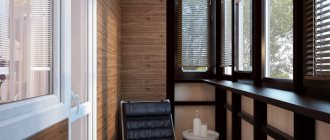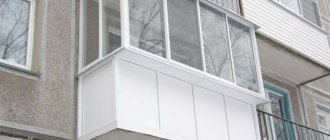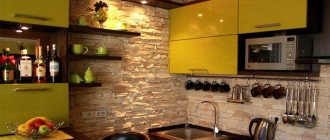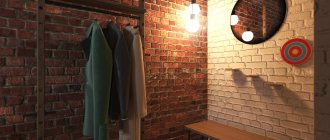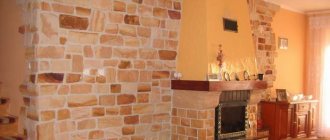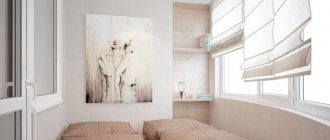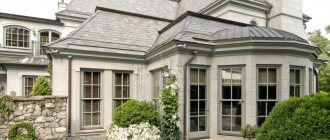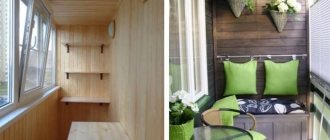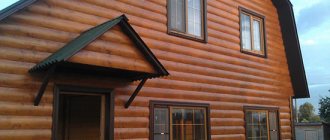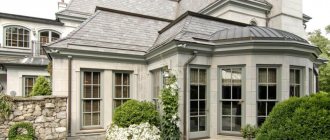Stone masonry has been one of the most popular materials for construction and interior decoration since ancient times. Strong, durable, environmentally friendly stone will be an excellent solution for both an apartment and a private house. They can decorate any room, from the hallway to the bathroom or kitchen.
The most popular option for using stone finishing is in the interior of a balcony. But there are certain nuances associated with the heavy weight and high cost of natural material. That is why in such cases decorative stone is more often used. You will learn further about what it is, how it differs from natural material and how it is used for finishing.
Benefits of stone finishing
Artificial or natural stone allows you to create incredibly luxurious and cozy interiors. This is an ideal material for arranging balconies, as it brings a touch of rural atmosphere - and this is what residents of big cities miss.
The advantages of finishing a balcony with stone include:
- reliability;
- durability;
- fire resistance;
- aesthetics;
- good compatibility with ceramics, wood, plaster and other finishing materials.
How to apply
When the walls are prepared accordingly, we begin to give our balcony a new look. The application steps are as follows:
- Cover the balcony door and baseboards with masking tape to prevent plaster from getting on them.
- Next, the decorative mixtures are diluted according to the instructions provided by the manufacturer (if ready-made ones are not used), strictly observing the recommended proportions. They are usually mixed with a drill with a special “mixer” attachment. At the same stage, if necessary, color is added.
- The finished composition is applied with a wide spatula or a smooth stainless grater, moving from corner to corner, from bottom to top. Make sure the layer is even. Craftsmen do not recommend taking breaks during work - then joints may be noticeable.
- When plastering and subsequent drying, the finishing on the balconies must be protected from the sun, wind, and moisture. Complete drying time is about two days. If pigment was not previously added to the mixture (some types of plaster do not provide for this), you need to paint the surface with interior or facade paint. We do this using a roller, in one pass.
Note. In some cases (if finishing particles can crumble), it is better to pre-treat the surfaces with a colorless primer before painting (we also wait for it to dry completely).
At the final stage, the decorative plaster is coated with varnish and wax (glossy, matte, waterproof or dirt-repellent). This process is called glazing.
Disadvantages of stone cladding
The disadvantage of stone balconies is the need to strengthen the working surfaces, which significantly complicates the work as a whole and contributes to an increase in its cost.
In addition, stone finishing cannot boast of environmental friendliness, unlike wooden ones.
Preparing the wall surface
In order for the “Bark Beetle” coating on the balcony to retain its original decorative appearance for a long time, you first need to carefully prepare the base. It can be brick, plasterboard, chipboard, concrete, sandwich panels or insulation. Provided the base is well prepared, the “bark beetle” will remain on the open balcony forever.
If necessary, the walls of the balcony are leveled with cement and sand mortar. If this is done in a place where the humidity periodically increases (open balconies and loggias), then the balcony wall is treated with a special anti-fungal solution before applying the leveling layer of ordinary plaster. Visible cracks and potholes of any size are cut out and filled with fresh plaster mortar. The minimum thickness of the leveling layer should be 2 cm.
When applying “Bark Beetle” to balcony walls that have recently been leveled with a cement-lime composition, no primer is required in principle. It is enough to moisten the surface with plain water. In other cases, the base should be thoroughly primed.
The bark beetle will not last long on balcony glazing or metal parts, but the material will have excellent adhesion to surfaces made of brick, concrete, and plasterboard. So, before applying Bark Beetle, the walls of the balcony should be thoroughly cleaned, degreased and leveled before use.
Often the decoration of a loggia or balcony with “Bark Beetle” is supposed to be colored. Then, 6 hours before applying it, the walls should be coated with a single-color paint - primer (for example, ST - 16). As a result, the base will not show through from under the colored decorative coating.
A natural stone
Due to its considerable weight and high cost, natural stone is not often used when decorating a balcony space. In addition, before use, it must be pre-treated.
In this case, a small radiation background will still remain. There are a number of other disadvantages:
- the need to use special equipment to carry out the work;
- exposure to temperature influences;
- low resistance to moisture.
Installation without jointing
- They start by establishing the future drawing. To do this, tiles are placed and selected to match each other. If necessary, notes are made in pencil.
- Next, mark the wall. And the slabs should not lie directly on the floor; they should be placed on a support.
- An adhesive solution is being prepared, which will soon be used to glue the tiles. For preparation, you should use the requirements from the instructions for use.
- Next, the required amount of glue is applied to the wall using a comb. It allows you to dose it correctly. It is important to monitor the required consistency of the applied building material.
- Then the glue is rubbed into the back of the sheets. And they immediately install individual decorative elements. They must be pressed firmly against the wall.
Fake diamond
Externally, natural and artificial stone are similar. But the latter has the following advantages:
- less weight;
- lower cost;
- absence of harmful radiation;
- resistance to moisture and cold;
- high thermal insulation qualities;
- biological safety;
- ease of installation;
- versatility;
- ease of care;
- resistance to mechanical damage.
Finishing a balcony with decorative stone may involve the use of imitation of both polished (porcelain stoneware) and natural (with an uneven surface coating) stone.
Also, such a finishing material can resemble rubble, cut or sawn stone, and also various bricks. As for colors, this is either a natural range or rich original colors.
It is worth saying a few words about agglomerate. This is an artificially created stone based on granite or marble chips. Used for cladding floors and walls.
Note!
Sofa on the balcony: functions and advantages of a sofa on the balcony. Selecting a model, size and shape. DIY instructions (photo + video)- Brick balcony - modern projects and recommendations on how to decorate a balcony with brick (175 photos)
Decorating a balcony with clapboards - detailed instructions on how to decorate a balcony quickly and beautifully (135 photos)
Depending on the form of production, artificial material can be in the form of wall panels or individual components.
Products made from stone chips
Products made from stone chips are the best solution for those who decide to make repairs themselves. Among this type there is the widest choice in texture, color, etc. They are easy to cut and install.
The thickness of the sheets and their dimensions vary among different manufacturers. Options made from acrylic or a composite base can have a thickness from 6 mm to 3.5 cm. The length and width of these products range from 25 by 25 cm to 30 by 8.8 centimeters. The dimensions of the sheets vary between 150-350 cm with a width of 50 to 80 cm. Weigh 1 square. m. can be from 11 to 35 kilograms.
You should not listen to those who talk about the ease of producing artificial stone at home. This can be done, of course, but in the end there will be so much dirt that it is more rational to purchase finished products. And in a good way, to create such slabs requires a separate building.
Slatted panels
Externally, these are slatted products. Slat panels can have different sizes. Area of application – lining of window and door openings.
Note!
Clothes dryer for the balcony - 105 photos of modern models and video instructions for their installation- Shelves on the balcony - practical ideas and detailed instructions on how to install and where best to place the shelves (115 photos)
Furniture for balconies - 125 photos and video descriptions of real examples of design of balconies and loggias
Application technique
After applying the plaster to the wall, use a brush to create horizontal and vertical lines intersecting each other in the form of squares.
Using a narrow spatula, you can create careless strokes on the wall of the loggia. To do this, you need to carefully, without pressing hard, apply a variety of strokes with smooth movements. They can be round, wavy, acute-angled, etc. This way you will create a unique design. Using a sponge you can create a relief wall surface. To do this, you need to apply the sponge to the wall, and, pressing lightly on it, turn it 180 degrees. You need to press the sponge approximately equally over the entire area.
Using a brush, you can create a rather interesting texture for your wall. The brush should be wide enough. After applying the plaster to the wall, use a brush to create horizontal and vertical lines intersecting each other in the form of squares. Simply brush over fresh plaster, applying light pressure to the brush. As a result, you will get uniform lines. There is a very interesting way to apply this material - using paper crumpled into a ball. The pattern turns out to be very interesting, and most importantly unique. Such a wall will definitely surprise your guests and delight you.
A plastered wall can be safely painted in any color you like. But it is also possible to add colors to the material itself. You need to add paint at the dilution stage. The surface dries within 2 days. Once it has completely dried, you can use a spatula to remove excess. The finished wall can be waxed. This is done to add shine and improve water repellency. So, there are many ways to apply decorative plaster. Creating relief and texture is like fingerprints, it is just as unique.
Rules of care
Finished walls can be washed using sponges or a soft cloth.
Caring for a wall finished with decorative plaster is quite simple. Due to the fact that this material is very moisture resistant, a dirty wall will be very easy to clean. It is enough to add any liquid detergent to plain water, including dishwashing detergent, washing powder, soap, etc., and apply the solution using a sponge or soft brush. For minor stains, using an ordinary damp cloth will suffice. The main thing is to never use abrasive cleaning products.
So, plaster is exactly the material with which you have the opportunity to experiment, try something new, create and create. It turns out that creating a masterpiece on your wall is not so difficult. A little imagination - and your wall will take on a unique look. In this way, you will emphasize not only your individuality, but also show yourself as a talented person, capable of creativity and creation. Don't be afraid to experiment. Only in such moments are masterpieces born.
”
Similar homemade products
Homemade wooden kitchen utensils: making a spoon
Shoe rack: easy and simple
Ottoman from a plastic bottle: do it yourself
Chair made from a metal barrel: do it yourself
Do-it-yourself garden chair: simple design
A very simple way to make a table from 150-gauge timber: do it yourself
Design options
As you can see in the photo of finishing a balcony with stone, it is customary to cover not continuous surfaces with it, but only some areas.
This material looks good against the background of plaster and wood. At the same time, it gives a feeling of naturalness and comfort. Most often, stone is used to decorate corners and openings.
Indoor flowers, wicker furniture, bleached linen or, conversely, bright textile details are in perfect harmony with the decoration of the balcony with artificial stone.
You should combine different materials, focusing either on color similarity or color difference.
So, if the walls are decorated in light colors, it is better to use dark stone elements. It is recommended to dilute dark brickwork with light-colored joints.
Note!
- Wardrobe on the balcony - features of the wardrobe on the balcony. Advantages and disadvantages. Varieties of cabinet models for balconies. Manufacturing and installation of a cabinet by hand (photo + video)
- Window sill on the balcony - functions and advantages of a window sill on the balcony. Types of window sills. Choice of material. Methods of fastening and installation (photo + video)
- Living room with a balcony - 115 photos of the best ideas and beautiful combinations of a balcony with a room
It is advisable to use stones of the original palette in combination with analogues that are calmer in color. This type of finishing is welcome in styles such as art deco, eclecticism, and oriental.
Experts advise using combinations of stones of different textures. Typically, the role of interior detail is assigned to a rougher material - they cover one of the walls or decorate openings.
We must not forget that the more restrained in shades and texture the decorative stone on the balcony is, the more picturesque and intricate the setting can be chosen for it.
We select the most suitable texture of products
Manufacturers prefer to give beautiful names to their products. After the design of the balcony, decorated with stone, has been thought out, the most successful texture of the decorative material is selected. The most common types are:
- Sandstones are characterized by a porous surface with small caverns. The tiles are as similar as possible to block masonry. The color range starts from straw tones and ends with rich browns.
- The limestone finish has smaller pores. Colors can have white and gray tones.
- Zeolite resembles granite. In the overall gray color there are red and pink elements.
- Quartzite, painted in gray, as well as in brown shades, among which there are red veins.
- The slate texture is characterized by a brown or gray background in which there are shiny grains of sand.
- The so-called “Wild Stone”, which is similar to the rough masonry of real granite, dolomite, etc.
Material selection criteria
When choosing an artificial stone, you should pay special attention to its composition. Are you planning a bright balcony in Scandinavian style?
You should choose a material based on white cement. With its help it will be easy to create the required atmosphere, but significant financial costs will be required.
Decorative stone with sand filler can boast the greatest strength. At the same time, it is characterized by a lot of weight. Working with such material will require special glue.
The most popular is gypsum-based stone. But it will need to be carefully coated with several layers of varnish after installation in order to avoid interaction with moisture.
When purchasing stone for finishing a balcony, you should definitely evaluate the quality. The coating should not be excessively porous, have foreign inclusions or uneven colors.
Seam processing
Laying with jointing is carried out in two stages:
- The tiles are glued onto the prepared surface, leaving a clearly adjusted distance between them within 0.5-1 cm. To simplify the work, strips of plasterboard or fiberboard of the required width can be laid between the rows.
- Joining the seams begins after the glue has completely dried. Using a grout syringe, fill the gaps between the tiles with the mixture, after which the excess is carefully removed.
The seams can not be filled completely, but not less than 0.5 in depth. Make sure that there are no gaps through which moisture can penetrate.
To ensure that the stonework retains its attractive appearance for a long time, it is coated with a protective acrylic-based varnish. It will give the finish additional shine and protect against moisture and dirt. You can use a brush or spray to apply the varnish.
Photo of finishing the balcony with stone
Arrangement of the loggia
The main disadvantage of balconies and loggias is the lack of heating. These rooms are considered auxiliary, but today it is quite easy to correct this situation. If it is not possible to tie into a central heating system, for example, in an apartment, you can always use electric heating mats, which do their job perfectly.
First of all, it is important to understand that a balcony and a loggia are different things:
- a balcony is a protrusion from the outer wall of a house, which is fenced off for safety;
- loggia - a separate room, which is most often glazed completely from the outside.
It is large panoramic windows that can play an important role in the design of the latter.
